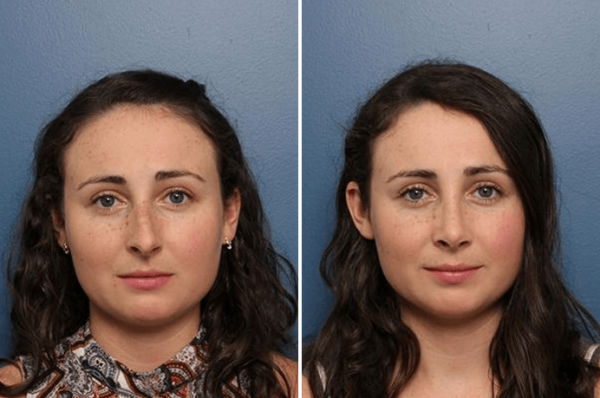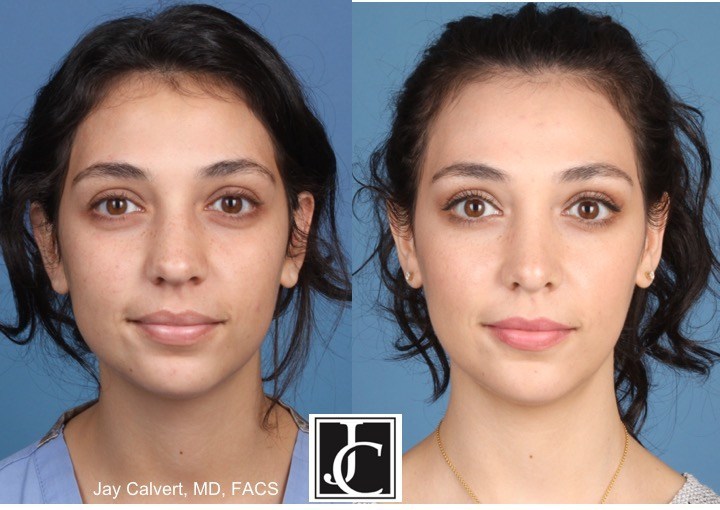Getting My Rhinoplasty Austin To Work
Table of ContentsThe 9-Second Trick For Rhinoplasty Austin TxAustin Rhinoplasty Fundamentals ExplainedRhinoplasty Austin Tx - The Facts
The septum is quadrangular; the upper half is flanked by two (2) triangular-to-trapezoidal cartilages: the upper lateral-cartilages, which are merged to the dorsal septum in the midline, and laterally attached, with loose ligaments, to the bony margin of the pyriform (pear-shaped) aperture, while the inferior ends of the upper lateral-cartilages are free (unattached).Underneath the upper lateral-cartilages lay the lower lateral-cartilages; the paired lower lateral-cartilages swing outwards, from medial attachments, to the caudal septum in the midline (the median crura) to an intermediate crus (shank) area. Lastly, the lower lateral-cartilages flare outwards, above and to the side (superolaterally), as the lateral crura; these cartilages are mobile, unlike the upper lateral cartilages.
e., an outside curving of the lower borders of the upper lateral-cartilages, and an inward curving of the cephalic borders of the alar cartilages. The type of the nasal subunitsthe dorsum, the sidewalls, the lobule, the soft triangles, the alae, and the columellaare configured in a different way, according to the race and the ethnic group of the patient, hence the nasal physiognomies denominated as: African, platyrrhine (flat, large nose); Asiatic, subplatyrrhine (low, wide nose); Caucasian, leptorrhine (narrow nose); and Hispanic, paraleptorrhine (narrow-sided nose).

The internal nasal valve consists of the location bounded by the upper lateral-cartilage, the septum, the nasal flooring, and the anterior head of the inferior turbinate. In the narrow (leptorrhine) nose, this is the narrowest part of the nasal air passage. Typically, this area needs an angle higher than 15 degrees for unobstructed breathing; for the correction of such narrowness, the width of the nasal valve can be increased with spreader grafts and flaring stitches.
Nasal anatomy: The philtrum. The surgical management of nasal problems and deformities divides the nose into 6 anatomic subunits: (i) the dorsum, (ii) the sidewalls (paired), (iii) the hemilobules (paired), (iv) the soft triangles (paired), (v) the alae (paired), and (vi) the columella. Surgical correction and reconstruction understand the whole anatomic subunit impacted by the problem (wound) or deformity, hence, the entire subunit is corrected, especially when the resection (cutting) of the defect includes more than half of the subunit.
Some Of Rhinoplasty Surgery Austin
The nasofrontal angle, between the frontal bone and the nasion typically is 120 degrees; the nasofrontal angle is more intense in the male face than in the female face. The nasofacial angle, the slope of the nose relative to the aircraft of the face, is around 3040 degrees. The nasolabial angle, the slope in between the columella and the philtrum, is roughly 9095 degrees in the male face, and roughly 100105 degrees in the female face.
When over here observed from below (worm's- eye view), the alar base sets up an isosceles triangle, with its apex at the infra-tip lobule, instantly underneath the pointer of the nose. The facially in proportion forecast of the nasal suggestion (the range of the nose's tip from the face) is identified with the Goode Method, in which the projection of the linked here nasal suggestion ought to be 5560 percent of the distance in between the nasion (nasofrontal junction) and the tip-defining point.
The Goode Technique determines the extension of the nose from the facial surface area by comprehending the range from the alar groove to the tip of the nose, and after that relating that measurement (of nasal-tip forecast) to the length of the nasal dorsum. The nasal forecast measurement is gotten by delineating a best triangle with lines parting from the nasion (nasofrontal juncture) to the alarfacialgroove. nose job austin.
55:1 to 0. 60:1, is the ideal nasal-tip-to-nasal-length projection. Nose Surgery: Nasal Class I - austin rhinoplasty surgery. The Roman nose. (Nasology Eden Warwick, 1848) Rhinoplasty: Nasal Class II. The Greek nose. (Nasology Eden Warwick, 1848) Nose Job: Nasal Class III. The African nose. (Nasology Eden Warwick, 1848) Rhinoplasty: Nasal Class IV. The Hawk nose. (Nasology Eden Warwick, 1848) Nose Job: Nasal Class V.
( Nasology Eden Warwick, 1848) Rhinoplasty: Nasal Class VI. The celestial nose. (Nasology Eden Warwick, 1848) To identify the client's suitability for going through a rhinoplasty treatment, the cosmetic surgeon scientifically assesses him or her with a total case history (anamnesis) to site link determine his/her physical and mental health. The prospective patient must explain to the physiciansurgeon the functional and aesthetic nasal problems that she or he suffers.

Moreover, additional to physical suitability is psychological suitabilitythe patient's psychological intention for undergoing nose surgery is important to the surgeon's pre-operative evaluation of the client. The total physical examination of the rhinoplasty patient determines if he or she is healthy to go through and endure the physiologic stresses of nose surgical treatment.
Some Ideas on Nose Job Austin Tx You Should Know
Specific facial and nasal evaluations record the client's skin-type, existing surgical scars, and the balance and asymmetry of the visual nasal subunits. The external and internal nasal assessment concentrates upon the structural thirds of the noseupper area, middle section, lower sectionspecifically noting their structures; the procedures of the nasal angles (at which the external nose projects from the face); and the physical qualities of the naso-facial bony and soft tissues.
Additionally, when required, particular teststhe mirror test, vasoconstriction evaluations, and the Cottle maneuverare included to the pre-operative evaluation of the potential rhinoplasty patient. Developed by Maurice H. Cottle (18981981), the Cottle maneuver is a primary diagnostic strategy for finding an internal nasal-valve disorder; whilst the client carefully influences, the surgeon laterally pulls the patient's cheek, thus simulating the widening of the cross-sectional location of the corresponding internal nasal valve.